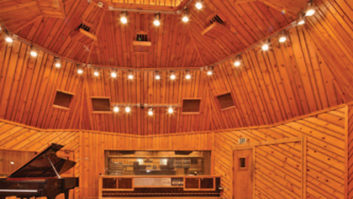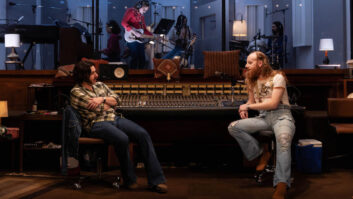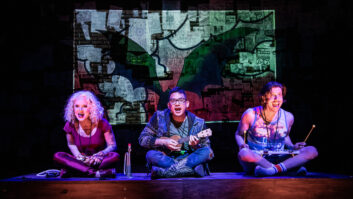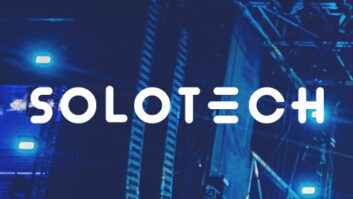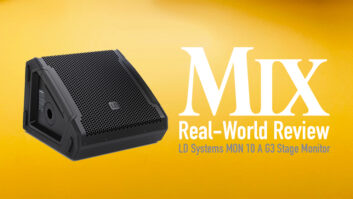With songs by rocker girl Cyndi Lauper and story by celebrated actor/playwright, Harvey Fierstein, Kinky Boots has Broadway on its proverbial feet. Based on the 2005 British flick about a struggling shoe factory that reinvigorates business by making fetish footwear for drag queens, the show opened to rave reviews—and a TONY award nom on the horizon. In keeping with many award-winning shows on the ‘Great White Way,’ sound designer John Shivers opted for a DiGiCo SD7T to handle the production, after becoming familiar with the system on his previous productions for Bonnie & Clyde, Sister Act and The Lion King overseas. The SD7’s powerful system and diminutive size made it a perfect fit for the new show.
“A few years ago, I saw a brief demo at Masque Sound when the SD7 first became available,” he recollected. “Seeing the feature set and the redundant engine and power supply all onboard got me interested. When designing The Lion King for Singapore in 2010, part of my negotiation involved suggesting that we swap out the Cadacs with SD7s in New York and London for both creative and financial reasons. Before I knew it, I’d gotten an email telling me to move forward. Within 6 weeks of that conversation we were implementing the SD7s on the New York show and a month after that we were doing the same in London. I’ve been using SD7s pretty much on every show since.”
Shivers says the console offers a lot of flexibility, especially with the new “T” software, which he says brings features and functionality specific to our needs on theatrical productions as well as a solid sounding foundation in a very compact package. “The SD7T software has added these very beneficial features thanks to [award-winning sound designer] Andrew Bruce’s involvement in the development. Having onboard compression, gating and delay—along with the programmability and recallability of those parameters on every channel—opens up possibilities that you just can’t have with an analog console. It’s definitely been an upgrade for us from that standpoint. A positive byproduct has definitely been the size of the console, which allows you to get into smaller spaces and require less seats and has served as a large financial windfall for producers. For me, from a purely creative and design standpoint, it’s about the capabilities of the console. I’m not one to follow the crowd necessarily, but the SD7 has become a standard of our industry and the reason everybody’s using them seems clear. It has proven itself to be a very capable and reliable console.”
“The SD7 with the ‘T’ software option has indeed proven to be a very good investment for Masque Sound,” says Masque’s Scott Kalata. “It has near-universal client acceptance, unlimited flexibility and its small footprint make it the ideal choice for today’s theatrical sound designer.”
The show’s Associate Sound Designer & Production Sound Engineer David Patridge (pictured at left with Shivers) has mixed on virtually every make and model DiGiCo has offered since the D5 in his two decades on Broadway. He, too, raves about the increased functionality that the Theatre Software offers.
“This is the number one reason for using SD7 in my opinion,” he offers. “We really appreciate all of the work that DiGiCo has undertaken, in tandem with Andrew Bruce, in developing a purpose-built version of the SD7 software for the theatrical market. DiGiCo has been very responsive in listening to end-users and new features are added and perfected constantly along with the elimination of oddities and bugs.
“I could fill pages on all of the features and how we use them. Specifically, the Auto Update is a great feature on its own but when it is employed as part of the theatre software it is really powerful and allows the desk to remain automated to a much larger degree than other types of desks. Typically, when using a recallable desk, you would need to dumb-down many of the features in order to avoid constantly recalling entirely new settings each time a scene is recalled. With the theatre software, you can expect the desk to operate in a ‘manual’ way but with full and selectable recall ability from moment to moment. On other productions such as The Lion King, we have enjoyed using the Gain Tracking ability of the desk in a creative new way. There is no other desk that I know of where you can assign headamps to a redundant set of control channels dedicated to band monitoring and then have the digital trim of those redundant channels track changes to the headamp. DiGiCo has really stepped up by providing a console that provides us with the greatest creative freedom when doing theatrical sound designs.”
“We use the onboard processing extensively for band reverbs and dynamics, which really cuts down on the real estate at the FOH position. The only outboard gear we’re using is a couple of Avalon Tube Compressors for our lead vocalists to fatten up their vocals. We also have a TC6000 System and Eventide H3000 for Vocal Effects/Reverbs etc. We are not using Waves yet, but I am interested in doing this in the future.”
The show’s system inputs total 116 analog and 6 AES, in addition to 60 analog outputs and 14 AES outputs. The production uses a pair of DiGiCo SD Racks along with the local I/O and MADI for the QLab playback system. They took advantage of the onboard MADI Split on the SD Rack in order to provide audio to a Yamaha PM5D monitor console. “The new racks offer a host of features positioning them well for use where audio is being split to a number of places like OB trucks etc., without needing to tap into the topology of the SD7 audio engines.”
By its very nature, Patridge explains, the SD7T solves many of the issues that crop up when dealing with a theatrical piece. “The cuelist structure, MIDI implementation, onboard input and output dynamics, the desk footprint and the Auto Update features not to mention the desk’s excellent sonic characteristics make choosing an SD7T a no-brainer. And in terms of flexibility and ease of use, I would say that DiGiCo is at the top of the ladder. There is no other digital desk that offers the same degree of theatrical features. The desk is also designed in such a way that it is very simple and intuitive to explain it to a new operator. Sonically I would say that that DiGiCo is on par with the top of the marketplace. Often the weakest link in any sound design is things like the content, mic positions or the room architecture. I don’t get the sense that any of the available top-of-the-line digital consoles add much of a sonic signature, although certainly you get what you pay for. We have been very pleased with the results that we get from DiGiCo desks.”
